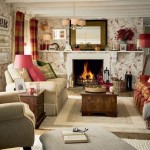Dining and Living Room Decorating Ideas
The dining room and living room often serve as the central hubs of a home, spaces where families gather, meals are shared, and memories are made. Decorating these areas effectively involves a thoughtful blend of aesthetics and functionality, creating an environment that is both visually appealing and conducive to comfortable living. Achieving this balance requires careful consideration of color palettes, furniture arrangement, lighting schemes, and decorative accents.
Effective decorating goes beyond simply filling a space with attractive items. It involves creating a cohesive narrative, reflecting the homeowners' personal style while also catering to the practical needs of the space. This requires a strategic approach, starting with understanding the room's dimensions, natural light sources, and intended use.
Defining Your Style and Purpose
Before embarking on any decorating project, it is crucial to define the desired style and purpose of both the dining room and the living room. Style can encompass a broad range of aesthetics, from traditional and formal to modern and minimalist, or even eclectic and bohemian. Determining the overarching style will significantly influence the selection of furniture, colors, and accessories.
Considerations should also include the primary function of each room. Will the dining room be used for formal dinners, casual family meals, or a combination of both? Will the living room serve as a space for relaxation, entertainment, or a home office? Understanding these functions will help guide decisions about furniture placement, storage solutions, and overall layout.
For example, a formal dining room might benefit from a large, elegant table, comfortable upholstered chairs, and a sophisticated chandelier. In contrast, a more casual dining area could feature a smaller, round table, simpler chairs, and pendant lighting. Similarly, a living room designed for relaxation might include a plush sofa, comfortable armchairs, and a warm, inviting color palette, while a living room intended for entertainment might require a larger seating area, a media center, and adequate space for movement.
Color Palette and Texture
The color palette of a dining room and living room significantly impacts the overall ambiance of the space. Color can evoke emotions, influence perceived size, and create visual harmony. Selecting the right color scheme is therefore a critical step in the decorating process.
Neutral colors, such as whites, grays, and beiges, often serve as a foundation for the room, providing a versatile backdrop that allows other elements to stand out. These neutral shades can be paired with accent colors to add personality and visual interest. Warm colors, such as reds, oranges, and yellows, can create a cozy and inviting atmosphere, while cool colors, such as blues, greens, and purples, can promote a sense of calm and relaxation.
Beyond color, texture plays a crucial role in adding depth and dimension to a space. Incorporating a variety of textures, such as smooth fabrics, rough wood, and metallic accents, can create a more visually appealing and tactilely engaging environment. For example, a living room might feature a plush velvet sofa, a woven rug, and textured throw pillows. In the dining room, a smooth glass tabletop could be contrasted with rough-hewn wooden chairs.
The interplay of light and color should also be taken into account. Natural light can significantly alter the appearance of colors, so it is important to test paint samples in the room under different lighting conditions. Darker colors tend to absorb light, making a space feel smaller and more intimate, while lighter colors reflect light, creating a sense of openness and airiness.
Furniture Arrangement and Space Planning
Strategic furniture arrangement is essential for maximizing functionality and creating a comfortable flow within the dining room and living room. The placement of furniture should consider the room's dimensions, natural light sources, and intended use.
In the dining room, the table typically serves as the focal point. Its size and shape should be proportional to the room's dimensions, allowing ample space for movement around the table. Chairs should be comfortable and appropriately sized for the table, ensuring that diners have adequate legroom. Consider the placement of other furniture, such as a buffet or sideboard, to provide storage and serving space.
In the living room, the arrangement of furniture should facilitate conversation and create a comfortable gathering space. The sofa is often the largest piece of furniture in the room and serves as the anchor for the seating arrangement. Armchairs, coffee tables, and side tables should be strategically placed to create a balanced and functional layout. Consider the placement of a television or fireplace, which can serve as focal points and influence the arrangement of other furniture.
Space planning involves carefully considering the flow of traffic within the room. Ensure that there is adequate space for people to move freely between different areas. Avoid overcrowding the room with too much furniture, which can make it feel cramped and uncomfortable. Utilize rugs to define different areas within the room and create visual separation.
Lighting and Ambiance
Effective lighting is crucial for creating the desired ambiance in the dining room and living room. Different types of lighting, including ambient lighting, task lighting, and accent lighting, should be used to create a layered and balanced lighting scheme.
Ambient lighting provides general illumination for the room and sets the overall mood. This can be achieved through ceiling fixtures, such as chandeliers or pendant lights, or through recessed lighting. Task lighting provides focused illumination for specific activities, such as reading or working. This can be achieved through table lamps, floor lamps, or under-cabinet lighting. Accent lighting highlights specific features of the room, such as artwork or architectural details. This can be achieved through spotlights, track lighting, or wall sconces.
In the dining room, a chandelier or pendant light suspended above the table can create a focal point and provide ambient lighting. Dimmer switches can be used to adjust the lighting levels and create a more intimate atmosphere. In the living room, a combination of ambient, task, and accent lighting can be used to create a warm and inviting atmosphere. Table lamps and floor lamps can provide task lighting for reading or other activities, while accent lighting can highlight artwork or architectural features.
The selection of light bulbs can also impact the ambiance of the room. Warm-toned light bulbs can create a cozy and inviting atmosphere, while cool-toned light bulbs can provide a brighter and more energizing effect. Consider using energy-efficient LED bulbs to reduce energy consumption and prolong bulb life.
Decorative Accents and Personalization
Decorative accents serve to personalize the dining room and living room, reflecting the homeowners' individual style and interests. These accents can include artwork, photographs, throw pillows, rugs, plants, and other decorative objects.
Artwork can add visual interest and personality to the walls. Choose pieces that complement the color palette and style of the room. Photographs can add a personal touch, showcasing cherished memories and loved ones. Throw pillows and rugs can add texture, color, and comfort to the space. Plants can add a touch of nature and improve air quality.
Personalization involves incorporating items that are meaningful to the homeowners. This can include family heirlooms, travel souvenirs, or handcrafted items. These items can add character and depth to the room, making it feel more unique and personal.
The arrangement of decorative accents should be carefully considered. Avoid cluttering the room with too many items, which can make it feel overwhelming. Instead, focus on selecting a few key pieces that complement each other and create a cohesive look. Grouping items together can create a more impactful display. For example, a collection of photographs can be arranged on a gallery wall, or a group of plants can be placed on a windowsill.
Storage Solutions and Organization
Effective storage solutions are essential for maintaining a clutter-free and organized dining room and living room. Adequate storage space can help keep the room tidy and functional, while also enhancing its aesthetic appeal.
In the dining room, consider incorporating storage solutions such as a buffet, sideboard, or china cabinet. These pieces can provide ample space for storing dishes, glassware, and other dining essentials. Shelving can also be used to display decorative items or store books and magazines.
In the living room, consider incorporating storage solutions such as a media center, bookshelves, or storage ottomans. These pieces can provide space for storing electronics, books, and other items. Baskets and bins can be used to organize smaller items, such as toys, magazines, or remote controls.
Consider utilizing vertical space to maximize storage capacity. Shelving can be installed on walls to create additional storage space without taking up valuable floor space. Floating shelves can also be used to display decorative items and add visual interest.
Organization is key to maintaining a clutter-free space. Regularly declutter the room and remove items that are no longer needed. Assign a designated place for everything and make it a habit to put things back in their place after use.

Living Room And Dining Design Ideas Designcafe

Living Room Dining Combo Ideas With Tricks Doğtaş

Living Room And Dining Design Ideas Designcafe

Living Room And Dining Decorating Ideas Design

Living Room Dining Combo Ideas Decorilla Portfolio

Perfect Ways To Decorate A Living Room With Dining Area Attached Unique And Design

5 Tips For Decorating A Combined Living Dining Room Happily Ever After Etc

30 Living Room Dining Combo Ideas 2025 One For All Rectangle Rectangular Rooms

Remarkable Pairings 40 Gorgeous Living Dining Combos

Living Room Dining Combo Ideas With Tricks Doğtaş
Related Posts







